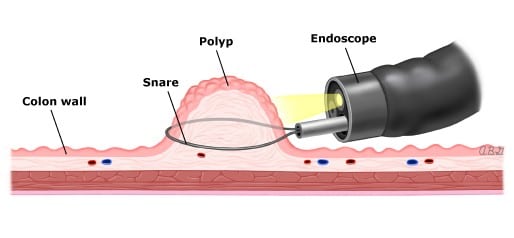Colon polyps are tiny growths that form on the inside of the large intestine (also known as the colon). Polyps are very common. About one-third to one-half of all adults have them by the time they are 50 years old. They do not usually cause symptoms. But some polyps can be or become cancer, so doctors sometimes remove them.
Colon polyps do not usually cause symptoms.
Doctors usually find colon polyps when they are doing screening tests to check for colon or rectal cancer. Cancer screening tests are tests that are done to try and find cancer early, before a person has symptoms. The screening tests for colon and rectal cancer include:
- Colonoscopy – Before having a colonoscopy, you will get medicine to help you relax. Then a doctor will put a thin tube into your anus and advance it into your colon. The tube has a camera attached to it, so the doctor can look inside your colon. The tube also has tools on the end, so the doctor can remove pieces of tissue, including polyps. After polyps are removed, they usually go to a lab to be tested for cancer and other problems.
- Sigmoidoscopy – A sigmoidoscopy is very similar to a colonoscopy. The only difference is that this test looks only at the first part of the colon, and a colonoscopy looks at the whole colon.
- CT colonography (also known as virtual colonoscopy) – For a virtual colonoscopy, you have a special kind of X-ray taken, called a “CT scan.” This test creates pictures of the colon.
- Stool test – “Stool” is another word for “bowel movements.” Stool tests check for blood or abnormal genes in samples of stool. If a stool test indicates that something might be wrong with the colon, doctors usually follow up with a colonoscopy. Then doctors find polyps, if they are there.
- Capsule colonoscopy – Rarely, your doctor might do something called a “capsule” colonoscopy. For this test, you swallow a special capsule that contains tiny wireless video cameras.
 Doctors remove polyps using the same tools they use for a colonoscopy. They can remove polyps either by snipping them off with a special cutting tool, or by catching the polyps in a noose. Most polyps can be removed during a colonoscopy. But sometimes, large polyps need to be removed at a later time, either with another colonoscopy or with surgery.
Doctors remove polyps using the same tools they use for a colonoscopy. They can remove polyps either by snipping them off with a special cutting tool, or by catching the polyps in a noose. Most polyps can be removed during a colonoscopy. But sometimes, large polyps need to be removed at a later time, either with another colonoscopy or with surgery.
You might need to have a colonoscopy every few years to check for more polyps. In some people polyps come back. And if you had the kind of polyps that could become cancer, your doctor will want to remove them as they appear. Also, if the polyps you had removed were the kind that could become cancer, people in your family might need to be checked for polyps and colon cancer earlier than if you did not have polyps.
Depending on your situation, your doctor might suggest genetic testing. This can show if your polyps are related to a specific gene that runs in families. If this turns out to be the case, they might recommend other tests that can be done to prevent cancer or find it early.
To reduce your chances of getting polyps or colon cancer:
- Eat a diet that is low in fat and high in fruits, vegetables, and fiber
- Lose weight, if you are overweight
- Do not smoke
- Limit the amount of alcohol you drink.



